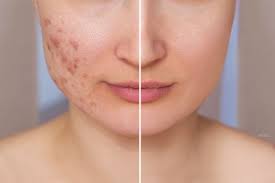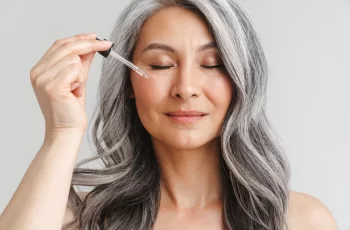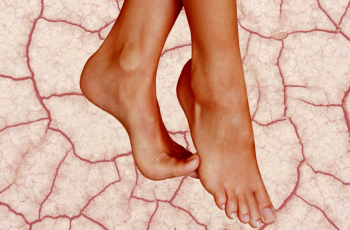Acne Scar Fillers: Everything You Need to Know About Minimally Invasive Treatments
Acne scars are like the guest you never invited to a party but show up anyway. After a pimple heals, your skin doesn’t always look the same as before, but can be left with red, raised, scarred, and even discolored spots. “This happens when your skin tries to repair itself but doesn’t do a perfect job,” says double-board certified dermatologist and Mohs surgeon Sami Khalifian, MD. If you’re wondering if there’s anything you can do about it, we have good news: More and more people are turning to dermal fillers for acne scars, which use an injectable solution to fill in pits and wrinkles after acne has healed.
Do you want to say goodbye to stubborn stains? Below, learn everything you need to know about acne scar fillers, including insights from dermatologists and plastic surgeons.
Meet the Experts
Ruth McTighe, MD, is a board-certified dermatologist at Waccamaw Dermatology in Mt. Pleasant, South Carolina.
Saami Khalifian, MD, is a double board-certified dermatologist and Mohs surgeon at Som Aesthetics.
Steven Dayan, MD, is a double board-certified plastic surgeon at Impressions: Face + Body Center in Chicago.
Why Choose Fillers for Acne Scars?
Dermal fillers are an effective way to correct scars that occur after a breakout. With some dermal fillers, like hyaluronic acid, you can even see results immediately. “Using fillers is one of several ways to restore the morphology and function of the skin in acne scars,” Khalifian says. “However, it is important to note that using fillers to treat acne scars is an advanced treatment technique and is considered an off-label use of these products.”
If you are frustrated or self-conscious about your acne scars, fillers are a treatment option to consider. However, you should keep in mind that fillers are only suitable for certain types of acne scars: “Fillers can be used for acne scars that leave depressions or holes in the skin,” Khalifian says.
What fillers can treat acne scars?
Bellafill
Bellafill is an FDA-approved dermal filler for the long-term treatment of moderate or severe atrophic acne scars, which are indented scars.1 Bellafill fillers are only for people over the age of 21. They are made of bovine collagen obtained from cows and polymethylmethacrylate (PMMA) beads.2 This type of filler works by supporting and adding volume to the skin.
Hyaluronic acid
Hyaluronic acid dermal fillers such as Juvederm and Restylane are fast-acting acne scar treatments. Board-certified dermatologist Ruth McTighe says these medications can temporarily increase volume and stimulate collagen production to improve depressed acne scars. “Combined with local anesthesia, the treatment is relatively painless, and you can leave the clinic and get results the same day,” says Khalifian.
Poly-L-lactic acid (Sculptra)
McTighe explains that poly-L-lactic acid (Sculptra) works gradually (meaning you won’t see results right away) to improve the appearance of acne scars by stimulating collagen production.
Radiesse
McTighe tells us that Radiesse is a calcium hydroxyapatite-based filler that adds volume to the skin immediately and boosts collagen production over time. Studies have shown it to be effective in treating depressed acne scars. “When diluted in a specific ratio, Radiesse can provide results faster than Sculptra because it provides an immediate lift and stimulates collagen and elastin over the long term,” Khalifian says.
Cost
Acne fillers vary in price, but typically cost between $600 and $1,200 per injection. “The number of injections and treatments required depends on the individual and the number of scars,” McTighe says. “Most fillers are temporary and can last anywhere from six months to two years, depending on the type of filler, the area being treated, and how quickly the body breaks down the filler.”
The Procedure
Before injecting a filler into your skin, consult with a physician who has experience injecting dermal fillers, such as a dermatologist. “Because this isn’t an ‘approved’ use filler, it may be harder to find a physician familiar with this treatment,” says Khalifian. “Also, the techniques used to treat acne scars are more complex than standard injection techniques, so they should be performed by a physician who has experience specifically treating acne scars with these products.” During your consultation, your physician will assess your acne scars, and you can ask questions about the cost of dermal fillers, expected risks, possible outcomes, and alternative treatment options.
Next, it’s time for the filler. “The treatment area is cleaned and a topical anesthetic cream is usually applied,” explains McTee. “The filler is then injected into the acne scar using a small needle or cannula. The appointment typically lasts 30 to 60 minutes, depending on the provider.”
Side Effects and Risks
Redness, bruising, or swelling may occur after the procedure, but these side effects are generally minor. It’s important to follow all of your doctor’s follow-up care instructions. “Filler injections are generally well tolerated, but as with any procedure, there are potential risks,” McTighe says. “These include injection site reactions such as redness, swelling, bruising, pain, bumps, skin discoloration, infection, and allergies.”
It’s also important to see an experienced doctor who can evaluate your skin and determine the best course of treatment for you. “While fillers are generally safe and carry minimal risks, it’s critical to choose an experienced physician,” says double-board certified plastic surgeon Steven Dayan. Be sure to tell your doctor about any allergies or sensitivities, and contact your doctor if you experience any signs of an adverse reaction.
Alternatives
While fillers can be an effective treatment for acne scars, they’re not the only option. Here are some alternatives your doctor may consider based on your budget, concerns, and scar severity.
Microneedling
Microdermabrasion
Chemical peels
Laser resurfacing
Fat grafting
Surgical options, such as subcision surgery
Sometimes your doctor will take a comprehensive approach, using two or more treatments to improve results, depending on your individual needs. “For those seeking more dramatic results, a combination of treatments is often recommended,” Dayan says. “Laser resurfacing and microdermabrasion combined with fat grafting are considered effective ways to achieve more substantial improvements in skin texture.”
Final Verdict
If you’re looking for a minimally invasive treatment for acne scars, dermal fillers are a good option. Dermal fillers are not FDA-approved for all types of acne scars, but are often used off-label to treat depressed scars. With some fillers, such as hyaluronic acid, the results are immediate, while others take longer to work. As with any treatment, it’s important to see a qualified specialist to learn more about this treatment and determine if it’s right for you.
DQH Knowledge drop: In your 20s, your skin cell turnover decreases. (Cell turnover is a key component in keeping your skin youthful.) You know what else slows down? Your collagen production. Starting in your 20s, collagen decreases by about 1 percent per year. Should you want to prevent fine lines and wrinkles, start by eliminating behaviors that contribute to premature aging. “If it’s bad for you, it’s bad for your skin,” says dermatologist Michel Somenek.
“Cigarette smoking reduces blood flow to the skin and causes premature wrinkling and a dull skin texture. Making the repeated pursed motion to inhale can also cause smoker’s lines. Alcohol and recreational drugs are toxins for the skin that damage its cellular structure and DNA,” Somenek tells us. “The faster you eliminate vices while you are young, the better chance your skin and body have to recuperate.” Also, adopting an anti-aging routine in your 20s is key. After all, the best offense is a good defense. We spoke to Somenek and experts Joshua Ross and Audrey Kunin to find out more.
Keep reading for the best anti-aging products for your 20s, according to skincare professionals.
Sunscreen
“We all know that the sun is the number one cause of skin aging and starting the prevention in your 20s is very important,” Ross says. “The majority of your sun damage won’t start to appear until you’re in your 30s, so don’t wait until you see it surface or you’ll be behind the curve. Stay ahead of it with a good-quality zinc-based sunscreen worn daily.”
Farmacy Green Defense Daily Mineral Sunscreen
An invisible sunscreen with SPF 30, plus botanical extracts meant to protect skin with tons of antioxidants. Bonus: It’s clean and fine to use under makeup.
Bareminerals Complexion Rescue™ Tinted Moisturizer Broad Spectrum SPF 30
Although we recommend you use your SPF and moisturizer separately, we also understand moments when you don’t have time or energy for that extra step. For those times, this bareMinerals moisturizer is a great thing to have on hand.
Vitamin C Serum
“A great introduction to anti-aging is to start with a vitamin C serum in your morning skincare routine,” Ross says. “It’s a powerful antioxidant that will neutralize free radicals and brighten the skin.” He adds that it’s a great way to counteract the effects of the sun’s harmful rays, which, as previously mentioned, are among the biggest causes of premature aging.
Drunk Elephant C-Firma™ Vitamin C Day Serum
The Drunk Elephant C-Firma is a lightweight serum that promises to give skin a glow by combining the brightening powers of vitamin C with ferulic acid, l-ascorbic acid, and vitamin E. The included sodium hyaluronate is meant to replace hydration loss, so you shouldn’t have to deal with any irritation.
Sunday Riley C.E.O. Rapid Flash Brightening Serum
This potent serum is jam-packed with vitamin C (15 percent, to be exact), which means it’s a potential superstar at both brightening skin and dousing it in antioxidants.
Peptides
Using peptides on your skin has many benefits, says Somenek. “The skin barrier is what defends the body against pollution, UV rays, bacteria, and toxins. It can be damaged by several everyday factors. Using topical peptides aids in building a stronger barrier,” he says. “Peptides comprise elastic fibers, which are a type of protein. These fibers help to make skin appear taut and firm. Peptides can also help repair damaged skin, relieve inflammation, and even out skin tone. Some peptides can kill acne-causing bacteria that is common in 20-somethings.”
Kunin agrees, saying, “Peptides are an excellent entry point for supporting collagen.” She recommends looking for face and eye treatments that contain these collagen-boosting powerhouses.
Charlotte Tilbury Magic Eye Rescue Cream
This Charlotte Tilbury super-emollient eye cream has a base of coconut oil and shea butter (read: it’s incredibly hydrating). Botanicals plus peptides are meant to help reduce dark circles and boost collagen, respectively.
This creamy moisturizer serves up potent collagen-boosting peptides and pycnogenol, and antioxidant-rich vitamin C. “Instead of sitting on top of the skin, peptides penetrate the outer layer so they go deep. The ‘signals’ they send tell the cells to produce elastin and collagen, which are needed for youthful-looking skin,” explains Somenek.
At-Home Peel Pads
Remember that skin cell turnover fiasco we talked about earlier? One way to help support it is by exfoliating. “Exfoliation is important to help keep skin fresh and luminous,” Kunin says. She recommends using at-home peel pads as an easy and effective way to exfoliate.
“The goal in your 20s is to fight the slowing pace of cell turnover. It is wise to use products that gently exfoliate, yet still remove oil and other impurities. Products that have Alpha Hydroxy Acids (AHA) or Beta Hydroxy Acids (BHA) are a good choice.”
According to Somenek, you should only exfoliate two to three times a week. “People of all ages are guilty of over-exfoliating and that can be too much of a good thing,” he says.
Dermadoctor Kakadu C Intensive Vitamin C Peel Pad
A few swipes of this Derma Doctor powerful peel pad promise to leave your skin glowing and smooth, thanks to the seven (yes, seven) types of chemical exfoliants, including AHA and BHA. It also contains vitamin C via Kakadu plum extract for added brightening and antioxidant protection.
KEY INGREDIENTS Kakadu plum extract is sourced from the Kakadu plum, a fruit grown in northern Australia. It contains vitamin C, which restores the skin’s natural barrier, increases collagen production, and soothes irritation.
Dr. Dennis Gross Skincare Alpha Beta® Universal Daily Peel Pads
These are the gold standard of peel pads, with a cult following and over 900 five-star reviews on Sephora. They’re easy to use and contain a blend of anti-aging exfoliating acids.
Emollient Night Cream
“In your 20s, you need to start upping the hydration in your skincare routine. You may have been cautious of over-moisturizing because of acne in your teens, but as you enter your 20s, your skin transitions and becomes drier,” Ross says. “I recommend an emollient night cream added into your evening skincare regimen.”
“Twenty-somethings need to make sure that they are not using creams that will clog their pores and cause excess oil production,” says Somenek. Opt for non-comedogenic products.
Cerave Skin Renewing Night Cream
One great choice is the CeraVe Skin Renewing Night Cream, which is a non-comedogenic night cream that leaves skin soft and glowy. It combines the moisturizing powers of ceramides and hyaluronic acid.
RoC Retinol Correxion Max Hydration Creme
“The best night cream ingredients contain retinol, benzoyl peroxide, and/or salicylic acid or hyaluronic acid. The goal is to moisturize, yet remove excess oil,” says Somenek. This Roc Retinol Correxion cream fits the bill as it contains both hyaluronic acid and retinol so it promises to moisturize while also being non-comedogenic.



